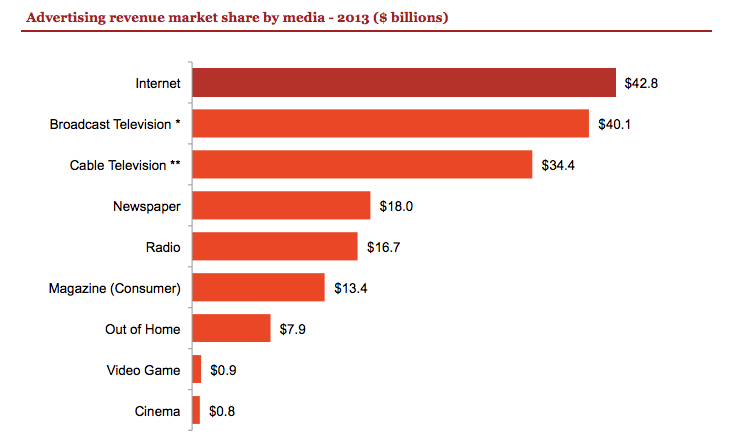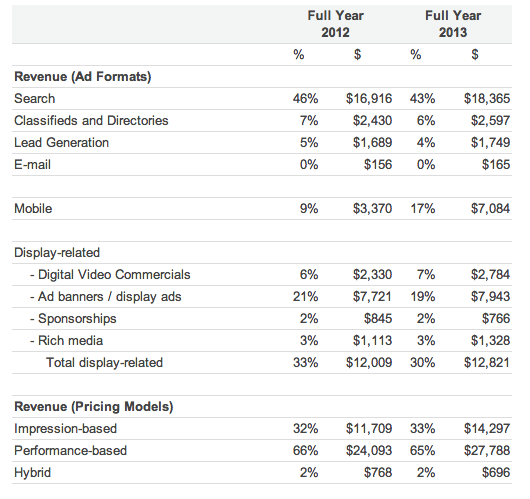Move over TV advertising, the digital revolution has officially taken a large bite out of your lunch!
In a recent report published by PriceWaterhouseCoopers and the Interactive Advertising Bureau, revenue from U.S. internet advertising surpassed broadcast television advertising revenue by almost $3 billion. For the first time ever, internet advertising revenue surpassed broadcast television advertising revenue, earning almost $43 billion. Broadcast Television came in second, earning $40 billion, and Cable Television came in third, earning $34 billion. Newspaper ($18 billion) and Radio ($17 billion) round out the top five.
Now online marketers can not boast too heavily, the combined television advertising revenue (Broadcast & Cable) dwarf the digital numbers, but this is the first step in the inevitable digital takeover. Digital advertising revenue saw the largest increase, with a 17% growth vs. 2012.
Digging into the number further shows that retail advertisers are the largest spenders by category, followed by financial services and automotive.
Search Marketing continues to reign supreme
Looking deeper into the digital advertising revenue numbers, you will see that search marketing continues to own the lion share of revenue, with revenue continuing to grow. Search marketing represents 46% of digital advertising revenue, and experienced a growth of 8.6% vs. 2012. This increase represents the success experienced by those properly employing search marketing. If Search Marketing isn’t a part of your online marketing mix, now is the perfect time to take advantage of this . While Search Marketing represents the largest share of revenue in digital advertising, it lost some of that share to mobile. Which leads us to the biggest winner from this research.
The Biggest winner
While digital is overtaking broadcast television as the medium producing the highest advertising revenue, the biggest takeaway of this report is in regards to mobile growth. Mobile advertising revenue doubled, contributing over $7 billion in advertising revenue, up from $3.3 billion in 2012. Mobile’s share of digital advertising revenue increased also, moving from 9% to 17% of total digital advertising revenue. Moral of the story, if you are not employing mobile as part of your digital marketing strategy, you are missing out.
Video online advertising adoption experiences growth
Digital video commercials experienced growth with a $400k or 16% increase. This 16% growth proves that with the rise of video adoption and viewership among consumers, digital marketers are experiencing success with video online advertising. Digital video commercials carved themselves out an additional percentage point of revenue share, in the overall digital advertising landscape. Video continues to grow in popularity, and video ad units are sure to grow along side.
But there is always a loser in every race
The casualty in this research was sponsored display media. This was the only digital marketing tactic that experienced a decline from 2012, and with it, lost share of spend. Sponsored digital content has seen its time in the spotlight and with consumers understanding what is sponsored and what is not sponsored, this decline should come as no surprise to the digital marketer.
Conclusion and Takeaways
If you ask any digital marketer, these research findings come as no surprise. To the small business owner, marketing manager or marketer looking to increase sales and conversions, this research proves that digital marketing is an advertising medium that produces success, and is here to stay. Total digital spend is second to Television and dominating other traditional advertising venues, such as Newspaper, Radio, and Publication.
This research bodes well for the digital marketer but also begs the question…. why are businesses still employing outdated and inefficient marketing tactics? Digital advertising have become such a vital part of the marketing mix and has a tremendous impact on reaching engaged audiences, it must be a part of your marketing strategy.


